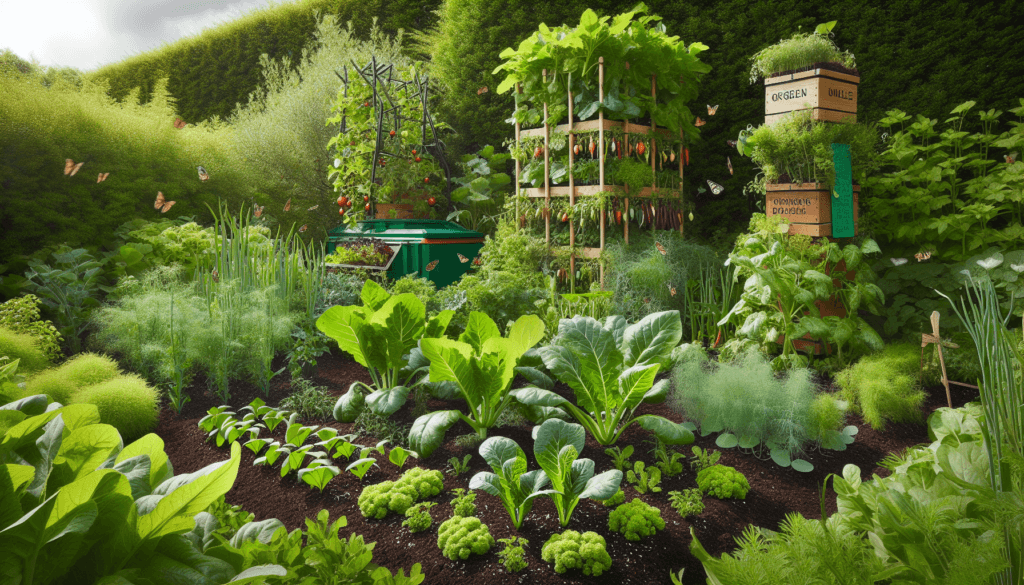Are you looking to create a sustainable and eco-friendly garden? If so, incorporating permaculture principles into your garden can be the solution you’ve been searching for. Permaculture is a holistic approach to gardening that focuses on designing systems that mimic natural ecosystems. By following these principles, you can optimize your garden’s productivity, conserve resources, and promote biodiversity. In this article, we will explore various ways you can incorporate permaculture principles into your garden, allowing you to create a beautiful and sustainable outdoor space. So, let’s dig in and discover how you can transform your garden into an ecological paradise.

1. Site Analysis
When starting a permaculture garden, it is essential to begin with a thorough analysis of your site. This will help you understand the unique characteristics of your land and make informed decisions about design and implementation. Observation is the first step in site analysis, where you spend time observing your garden throughout the year. Look for patterns of sunlight and shade, wind direction, and areas with excessive moisture or dryness. These observations will help you identify microclimates within your garden, which are areas that have distinct climate conditions due to factors such as sun exposure and shelter. Understanding these microclimates will allow you to choose plants and design features that thrive in specific conditions.
Another crucial aspect of site analysis is soil analysis. Take the time to assess the composition and health of your soil. Consider factors such as texture, drainage, and nutrient levels. This information will guide you in making decisions about soil improvement techniques, such as composting and cover cropping.
2. Designing for Function
Permaculture emphasizes designing for function to create a sustainable and efficient garden. Zone planning is an essential technique where you divide your garden into different zones based on frequency of use and plant requirements. For example, Zone 1 would be the area closest to your home, where you grow frequently harvested crops and herbs. Zone 5, on the other hand, would be a wild area left mostly untouched to encourage biodiversity.
Sector analysis involves identifying external influences on your garden, such as prevailing winds or the path of the sun. By understanding these influences, you can strategically place features like windbreaks or sun-loving plants to maximize energy efficiency and provide shelter for more delicate plants.
Keyline design is another technique used to optimize water flow in your landscape. By analyzing the natural slope of your land, you can contour it to capture and distribute water effectively. This creates a more efficient use of water resources and helps prevent erosion.

3. Building Healthy Soil
One of the foundations of permaculture is building and maintaining healthy soil. Composting is an excellent way to recycle organic waste and create nutrient-rich soil amendment. Collect kitchen scraps, yard waste, and other organic material and create a compost pile. Turn it regularly to encourage decomposition and microbial activity. Soon, you will have a nutrient-dense compost that you can use to feed your plants.
Cover cropping is another technique used to improve soil health. By growing specific plants that have deep root systems or nitrogen-fixing abilities, you can improve soil structure, add organic matter, and suppress weeds. Cover crops also prevent erosion and provide habitat for beneficial insects.
Sheet mulching is a method of creating new planting beds without the need for digging or tilling. Layer cardboard or newspaper over the grass or weeds, then cover with compost and mulch. This creates a nutrient-rich environment for planting while smothering unwanted vegetation.
4. Water Conservation
In a permaculture garden, water conservation is of utmost importance. Rainwater harvesting is an effective way to capture and store rainwater, reducing reliance on municipal water sources. Install rain barrels or tanks to collect runoff from rooftops or create swales, which are shallow trenches along contour lines, to redirect water to desired areas.
Another water conservation technique is the use of swales and berms. These are earthworks designed to slow down and capture water. By creating small, gentle slopes in your landscape, you can improve water infiltration and prevent runoff. This ensures that water stays in your garden, nourishing plants and recharging groundwater sources.
Graywater systems allow you to reuse household wastewater from sources such as sinks, showers, or laundry machines to irrigate your garden. Properly filtered and directed, graywater can be safely used to water non-edible plants, reducing overall water consumption.

5. Plant Guilds and Polycultures
Plant guilds and polycultures are techniques that mimic natural plant communities and enhance overall garden productivity. Companion planting involves growing plants together that have beneficial relationships, such as pest deterrence or nutrient sharing. For example, planting marigolds next to tomatoes can help repel pests, while beans contribute nitrogen to the soil, benefiting neighboring plants.
Succession planting involves strategically timing the planting of different crops in order to maximize growing space and continual harvest. By planting quick-growing crops after harvesting others, you can ensure a continuous supply of fresh produce throughout the growing season.
Crop rotation is another important practice that helps manage pests and maintain soil fertility. By rotating crops from different plant families, you disrupt pest life cycles and prevent the buildup of soil-borne diseases. Additionally, rotating nitrogen-fixing legumes with other crops can help replenish soil nutrients naturally.
6. Integrated Pest Management
Permaculture focuses on managing pests in a holistic and ecologically friendly manner. Beneficial insects, such as ladybugs and lacewings, can be attracted to your garden by providing a diverse range of plants that offer nectar and pollen. These insects help control pest populations, reducing the need for chemical pesticides.
Natural predators, such as birds and frogs, also play a crucial role in pest management. Create habitats and provide food sources for these predators to encourage their presence in your garden. This way, they can naturally keep pest populations in check.
Trap crops are plants specifically grown to attract and distract pests away from your desired crops. For example, planting a few sacrificial plants like nasturtiums can lure aphids away from your vegetables. By regularly inspecting and removing the pest-infested trap crops, you can control pest populations while protecting your main crops.

7. Wildlife Habitat
Creating a thriving wildlife habitat in your garden is not only beneficial for the environment but also contributes to a balanced ecosystem. Planting native plants provides food and shelter for local wildlife, supporting biodiversity. Choose a variety of plants that offer nectar, berries, or seeds to attract birds, butterflies, and other beneficial insects.
Incorporate habitat elements such as birdhouses, bat boxes, or small ponds to encourage wildlife to take up residence in your garden. These elements provide additional shelter and breeding opportunities, creating a diverse and lively ecosystem.
Adopt wildlife-friendly practices by avoiding the use of chemical pesticides and herbicides, which can harm beneficial insects and contaminate water sources. Instead, focus on natural pest management techniques and choose organic alternatives for disease or weed control.
8. Energy Efficiency
Permaculture gardens prioritize energy efficiency to reduce reliance on non-renewable resources. Utilizing solar power is an excellent way to harness clean energy. Install solar panels to generate electricity for lighting, water pumps, and other garden infrastructure. This helps decrease your carbon footprint and lower energy costs.
Passive design techniques optimize natural elements such as sunlight and shading to regulate temperature in your garden. By strategically placing deciduous trees to provide shade in summer while allowing sunlight to warm the space in winter, you can reduce the need for artificial heating or cooling.
Using energy-efficient appliances, such as energy-rated pumps, lights, and tools, further minimizes energy consumption. Choose products with high energy efficiency ratings to reduce electricity usage and decrease your environmental impact.

9. Resource Cycling
Resource cycling is a fundamental principle of permaculture, where waste is minimized, and materials are recycled within the garden ecosystem. Recycling is an essential component of resource cycling. Set up a system for collecting and recycling materials such as plastic, glass, and metal. Try to minimize waste by reusing items and repurposing them for garden projects.
Composting is another key element of resource cycling. As mentioned earlier, create a compost pile using organic waste from your garden and kitchen. This compost will then break down into nutrient-rich soil amendment, closing the loop and improving overall soil health.
Mulching is another technique used to cycle resources in your garden. Layer organic mulch, such as straw, wood chips, or leaves, over the soil surface. This helps retain moisture, suppress weeds, and gradually decompose, providing additional nutrients for your plants.
10. Community Engagement
Community engagement is an important aspect of permaculture, fostering the sharing of knowledge, resources, and inspiration. Share resources within your community by participating in tool libraries or seed exchanges. This reduces waste and promotes a sense of cooperation and collaboration among gardeners.
Educational programs can be organized to teach the principles and practices of permaculture. Offer workshops, classes, or guided tours in your garden to inspire and educate others about sustainable gardening techniques. This helps spread the permaculture movement and encourages more people to adopt these principles.
Community gardens are another avenue to promote permaculture and engage with others. Participate in community gardening projects where individuals come together to cultivate and share a common space. This creates a sense of belonging, fosters social interaction, and allows for collective learning and support.
Incorporating permaculture principles into your garden not only benefits the environment but also enhances your gardening experience. By applying these strategies, you can create a sustainable and resilient garden that thrives while minimizing negative impacts on the planet. So roll up your sleeves, put on your gardening gloves, and embark on your permaculture journey!


